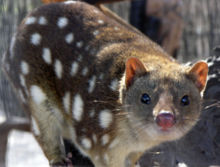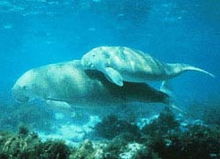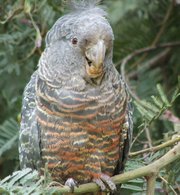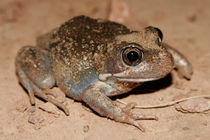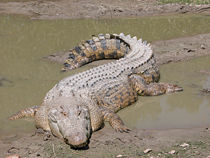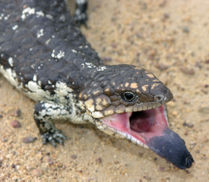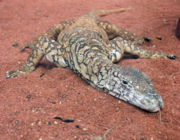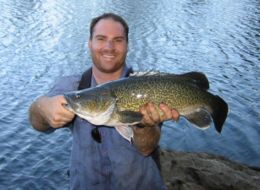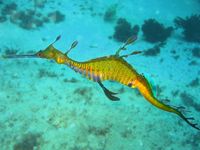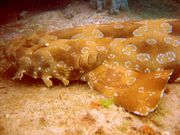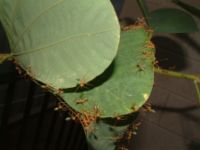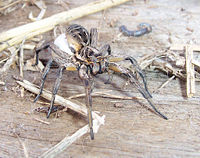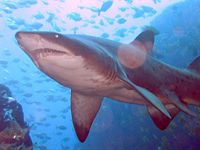Fauna of Australia
2008/9 Schools Wikipedia Selection. Related subjects: Biology; Geography of Oceania (Australasia)
The fauna of Australia consists of a huge variety of unique animals; some 83% of mammals, 89% of reptiles, 90% of fish and insects and 93% of amphibians that inhabit the continent are endemic to Australia. This high level of endemism can be attributed to the continent's long geographic isolation, tectonic stability, and the effects of an unusual pattern of climate change on the soil and flora over geological time. A unique feature of Australia's fauna is the relative scarcity of native placental mammals. Consequently the marsupials—a group of mammals that raise their young in a pouch, including the macropods, opossums and dasyuromorphs—occupy many of the ecological niches placental animals occupy elsewhere in the world. Australia is home to two of the five known extant species of monotremes and has numerous venomous species, which include the Platypus, spiders, scorpions, octopus, jellyfish, molluscs, stonefish, and stingrays. Uniquely, Australia has more venomous than non-venomous species of snakes.
The settlement of Australia by Indigenous Australians more than 40,000 years ago, and by Europeans from 1788, has significantly affected the fauna. Hunting, the introduction of non-native species, and land-management practices involving the modification or destruction of habitats have led to numerous extinctions. Some examples include the Paradise Parrot, Pig-footed Bandicoot and the Broad-faced Potoroo. Unsustainable land use still threatens the survival of many species. To target threats to the survival of its fauna, Australia has passed wide-ranging federal and state legislation and established numerous protected areas.
Origins

Both geologic and climatic events helped to make Australia's fauna unique. Australia was once part of the southern supercontinent Gondwana, which also included South America, Africa, India and Antarctica. Gondwana began to break up 140 million years ago (MYA); 50 MYA Australia separated from Antarctica and was relatively isolated until the collision of the Indo-Australian Plate with Asia in the Miocene era 5.3 MYA. The establishment and evolution of the present-day fauna was apparently shaped by the unique climate and the geology of the continent. As Australia drifted, it was, to some extent, isolated from the effects of global climate change. The unique fauna that originated in Gondwana, such as the marsupials, survived and adapted in Australia.
After the Miocene, fauna of Asian origin were able to establish themselves in Australia. The Wallace Line—the hypothetical line separating the zoogeographical regions of Asia and Australasia—marks the tectonic boundary between the Eurasian and Indo-Australian plates. This continental boundary prevented the formation of land bridges and resulted in a distinct zoological distribution, with limited overlap, of most Asian and Australian fauna, with the exception of birds. Following the emergence of the circumpolar current in the mid-Oligocene era (some 15 MYA), the Australian climate became increasingly arid, giving rise to a diverse group of arid-specialised organisms, just as the wet tropical and seasonally wet areas gave rise to their own uniquely adapted species.
Mammals
Australia has a rich mammalian fossil history, as well as a variety of extant mammalian species, dominated by the marsupials. The fossil record shows that monotremes have been present in Australia since the Early Cretaceous 145–99 MYA, and that marsupials and placental mammals date from the Eocene 56–34 MYA, when modern mammals first appeared in the fossil record. Although marsupials and placental mammals did coexist in Australia in the Eocene, only marsupials have survived to the present. The placental mammals made their reappearance in Australia in the Miocene, when Australia moved closer to Indonesia, and bats and rodents started to appear reliably in the fossil record. The marsupials evolved to fill specific ecological niches, and in many cases they are physically similar to the placental mammals in Eurasia and North America that occupy similar niches, a phenomenon known as convergent evolution. For example, the top predator in Australia, the Tasmanian Tiger, bore a striking resemblance to canids such as the Gray Wolf; gliding opossums and flying squirrels have similar adaptations enabling their arboreal lifestyle; and the Numbat and anteaters are both digging insectivores.
Monotremes and marsupials
Monotremes are mammals with a unique method of reproduction: they lay eggs instead of giving birth to live young. Two of the five known living species of monotreme occur in Australia: the Platypus and the Short-beaked Echidna. The Platypus — a venomous, egg-laying, duck-billed, amphibious mammal — is one of the strangest creatures in the animal kingdom. When a Platypus pelt was first presented by Joseph Banks to English naturalists in the late 18th century, they were convinced it must be a cleverly created hoax. Another strange monotreme is the Short-beaked Echidna; covered in hairy spikes, with a tubular snout in the place of a mouth, it has a tongue that can move in and out of the snout about 100 times per minute to capture termites.
Australia is also home to the world's largest and most diverse selection of marsupials: mammals with a pouch in which they rear their young. The marsupial carnivores — order Dasyuromorphia — are represented by two surviving families: the Dasyuridae with 51 members, and the Myrmecobiidae with the Numbat as its sole surviving member.
The Thylacine, or Tasmanian Tiger was the largest Dasyuromorphia and the last living specimen of the family Thylacinidae; however, the last known specimen died in captivity in 1936. The world's largest surviving carnivorous marsupial is the Tasmanian Devil; it is the size of a small dog and can hunt, although it is mainly a scavenger. It became extinct on the mainland some 600 years ago and is now found only in Tasmania. There are four species of quoll, or native cat, all of which are threatened species. The remainder of the Dasyuridae are referred to as 'marsupial mice'; most weigh less than 100 grams. There are two species of marsupial mole — order Notoryctemorphia — that inhabit the deserts of Western Australia. These rare, blind, earless carnivores spend most of their time underground; little is known about them.
The marsupial omnivores include the bandicoots and bilbies, order Peramelemorphia. There are seven species in Australia, most of which are endangered. These small creatures share several characteristic physical features: a plump, arch-backed body with a long, delicately tapering snout, large upright ears, long thin legs, and a thin tail. The evolutionary origin of this group is unclear, but they share characteristics from both carnivorous and herbivorous marsupials.
The marsupial herbivores are classified in the order Diprotodontia, and further into the suborders Vombatiformes, Phalangeriformes and Macropodiformes. The Vombatiformes include the Koala and the three species of wombat. One of Australia's best-known marsupials, the Koala is an arboreal (tree-dwelling) species that feeds on the leaves of some 120 species of eucalyptus. Wombats, on the other hand, live on the ground and feed on grasses, sedges and roots. Wombats use their rodent-like front teeth and powerful claws to dig extensive burrow systems; they are mainly crepuscular and nocturnal. Wombats are also well known for their backwards facing pouches.
The Phalangeriformes includes possums and is a diverse group of arboreal marsupials, including six families and 26 species. They vary in size from the Pygmy possum, weighing just 7 g, to the cat-sized Common Ringtail and Brushtail possums. The Sugar and Squirrel Gliders are common species of gliding possum, found in the eucalyptus forests of eastern Australia, while the Feathertail Glider is the smallest glider species. The gliding opossums have membranes, called "patagiums," that extend from the fifth finger of their forelimb back to the first toe of their hind foot. These membranes, when outstretched, allow them to glide between trees.
The Macropodiformes are divided into three families that are found in all Australian environments except alpine areas: the Hypsiprymnodontidae, with the Musky Rat-kangaroo as its only member; the Potoroidae, with 10 species; and the Macropodidae which had 53 members in Australia, but some species are extinct. The Potoroidae include the bettongs, potaroos and rat-kangaroos, small species that make nests and carry plant material with their tails. The Macropodiae include kangaroos, wallabies and associated species; size varies widely within this family. Most macropods move in a bipedal, energy-efficient hopping motion. They have powerfully muscled tails and large hind legs with long narrow hind feet. The hind feet have a distinctive arrangement of four toes, while the short front legs have five separate digits. The Musky Rat-kangaroo is the smallest macropod and the only species that is not bipedal, while the male Red Kangaroo is the largest, reaching a height of about 2 m and weighing up to 85 kg.
Placental mammals

Australia has indigenous placental mammals from two orders: the bats, order Chiroptera, represented by six families, and the mice and rats, order Rodentia, family Muridae. Bats and rodents are relatively recent arrivals to Australia. Bats probably arrived from Asia, and they are present in the fossil record only from as recently as 15 MYA. Although 7% of the world's bats species live in Australia, there are only two endemic genera of bats. Rodents first arrived in Australia 5–10 MYA and underwent a wide radiation to produce the species collectively known as the "old endemic" rodents. The old endemics are represented by 14 extant genera. About a million years ago, the rat entered Australia from New Guinea and evolved into seven species of Rattus, collectively called the "new endemics."
Since human settlement, many placental mammals have been introduced to Australia and are now feral. The first was the Dingo; fossil evidence suggests that people from the north brought the Dingo to Australia about 5,000 years ago. When Europeans settled Australia they intentionally released many species into the wild, including the Red Fox, Brown Hare, and the European Rabbit. Other domestic species have escaped and over time have produced wild populations including the cat, Fallow Deer, Red Deer, Sambar Deer, Rusa Deer, Chital, Hog Deer, Domestic Horse, Donkey, Pig, Domestic Goat, Water Buffalo, and the Dromedary. Only three species of Australia's non-indigenous placental mammals were not deliberately introduced: the House Mouse, Black Rat and the Brown Rat.
Forty-six marine mammals from the order Cetacea are found in Australian coastal waters, but since many of these species have a global distribution, some authors do not consider them Australian species. There are nine species of baleen whale, including the enormous Humpback Whale. There are 37 species of toothed whale, which include all six genera of the family Ziphiidae ( Beaked whales), and 21 species of oceanic dolphin, including the Australian Snubfin Dolphin, a species first described in 2005. Some oceanic dolphins, such as the Orca, can be found in all waters around the continent; others, such as the Irrawaddy Dolphin, are confined to the warm northern waters. The Dugong (Order Sirenia) is an endangered marine species that inhabits the waters of northeastern and northwestern Australia, particularly the Torres Strait. It can grow up to 3 m long and weigh as much as 400 kg. The dugong is the only herbivorous marine mammal in Australia, feeding on sea grass in coastal areas. The destruction of sea grass beds is a threat to the survival of this species.
Ten species of seals and sea-lions (superfamily Pinnipedia) live off the southern Australian coast and in Sub-Antarctic Australian territories.
Birds

Australia and its territories are home to over 800 species of bird; about 350 of these are endemic to the zoogeographic region that covers Australia, New Guinea and New Zealand. The fossil record of birds in Australia is patchy; however, there are records of the ancestors of contemporary species as early as the Late Oligocene. Birds with a Gondwanan history include the flightless ratites (the Emu and Southern Cassowary), megapodes (the Malleefowl and Australian Brush-turkey), and a huge group of endemic parrots, order Psittaciformes. Australian parrots comprise a sixth of the world’s parrots, including many cockatoos and galahs. The Kookaburra is the largest species of the kingfisher family, known for its call, which sounds uncannily like loud, echoing human laughter.
The passerines of Australia, also known as songbirds or perching birds, include wrens, robins, the magpie group, thornbills, pardalotes, the huge honeyeater family, treecreepers, lyrebirds, birds of paradise and bowerbirds. The Satin Bowerbird is a fascinating bird that has attracted the interest of evolutionary psychologists: it has a complex courtship ritual in which the male creates a bower filled with blue, shiny items to woo mates.
Relatively recent colonists from Eurasia are swallows, larks, thrushes, cisticolas, sunbirds, and some raptors, including the large Wedge-tailed Eagle. A number of bird species have been introduced by humans; some, like the European Goldfinch and Greenfinch, coexist happily with Australian species, while others, such as the Common Starling, Common Blackbird, House Sparrow and Indian Mynah, are destructive of some native bird species and thus destabilise the native ecosystem.
About 200 species of seabird live on the Australian coast, including many species of migratory seabird. Australia is at the southern end of the East Asian-Australasian flyway for migratory water birds, which extends from Far-East Russia and Alaska through Southeast Asia to Australia and New Zealand. About two million birds travel this route to and from Australia each year. One very common large seabird is the Australian Pelican, which can be found in most waterways in Australia. The Little Penguin is the only species of penguin that breeds on mainland Australia.
Amphibians and reptiles
Australia has four families of native frogs and one introduced toad, the Cane Toad. In 1935 the Cane Toad was introduced to Australia in a failed attempt to control pests in sugarcane crops. It has since become a devastating pest, spreading across northern Australia. As well as competing with native insectivores for food, the Cane Toad produces a venom that is toxic to native fauna, as well as to man. The Myobatrachidae, or southern frogs, are Australia's largest group of frogs, with 120 species from 21 genera. A notable member of this group is the colourful and endangered Corroboree Frog. The tree frogs, from family Hylidae, are common in high rainfall areas on the north and east coasts; there are 77 Australian species from three genera. The 18 species from two genera of the Microhylidae frogs are restricted to the rainforests; the smallest species, the Scanty Frog, is from this family. There is a single species from the world's dominant frog group, family Ranidae — the Australian Wood Frog — which only occurs in the Queensland rainforests. As elsewhere, there has been a precipitous decline in Australia's frog populations in recent years. Although the full reasons for the decline are uncertain, it can be at least partly attributed to the fatal amphibian fungal disease chytridiomycosis.
Australia has both saltwater and freshwater crocodiles. The Saltwater Crocodile, known colloquially as the "salty," is the largest living crocodile species; reaching over 7 m and weighing over 1,000 kg, they can and do kill people. They live on the coast and in the freshwater rivers and wetlands of northern Australia, and they are farmed for their meat and leather. Freshwater Crocodiles, found only in Northern Australia, are not considered dangerous to man.
The Australian coast is visited by six species of sea turtle: the Flatback, Green Sea, Hawksbill, Olive Ridley, Loggerhead and the Leatherback Sea Turtles; all are protected in Australian waters. There are 29 species of Australian freshwater turtles from eight genera of family Chelidae. The Pig-nosed Turtle is the only Australian member of that family. Australia and Antarctica are the only continents without any living species of land tortoise.
Australia is the only continent where venomous snakes outnumber their non-venomous cousins. Australian snakes belong to seven families. Of these, the most venomous species, including the Fierce Snake, Eastern Brown Snake, Taipan and Eastern Tiger Snake are from the family Elapidae. Of the 200 species of elapid, 86 are found only in Australia. Thirty-three sea snakes from family Hydrophiidae inhabit Australia's northern waters; many are extremely venomous. Two species of sea snake from the Acrochordidae also occur in Australian waters. Australia has only 11 species from the world's most significant snake family Colubridae; none are endemic, and they are considered to be relatively recent arrivals from Asia. There are 15 python species and 31 species of insectivorous blind snake.
There are more lizards in Australia than anywhere else in the world, with representatives of five families. There are 114 species in 18 genera of gecko found throughout the Australian continent. The Pygopodidae is a family of limbless lizards endemic to the Australian region; of the 34 species from eight genera, only one species does not occur in Australia. The Agamidae or Dragon lizards are represented by 66 species in 13 genera, including the Thorny Devil, Bearded Dragon and Frill-necked Lizard. There are 26 species of monitor lizard, family Varanidae, in Australia, where they are commonly known as goannas. The largest Australian monitor is the Perentie, which can reach up to 2 m in length. There are 389 species of skink from 38 genera, comprising about 50% of the total Australian lizard fauna; this group includes the blue-tongued lizards.
Fish
More than 4,400 species of fish inhabit Australia's waterways; of these, 90% are endemic. However, because of the relative scarcity of freshwater waterways, Australia has only 170 species of freshwater fish. Two families of freshwater fish have ancient origins: the arowana or "bony tongues," and the Queensland lungfish. The Queensland lungfish is the most primitive of the lungfish, having evolved before Australia separated from Gondwana. One of the smallest freshwater fish, peculiar to the southwest of Western Australia, is the salamanderfish, which can survive desiccation in the dry season by burrowing into mud. Other families with a potentially Gondwanan origin include the Retropinnidae, Galaxiidae, Aplochitonidae and Percichthyidae. Apart from the ancient freshwater species, 70% of Australia's freshwater fish have affinities with tropical Indo-Pacific marine species that have adapted to freshwater. Nevertheless, fossil evidence indicates that many of these freshwater species are still ancient in origin. These species include freshwater lampreys, herrings, catfish, rainbowfish, and some 50 species of gudgeon, including the Sleepy Cod. Native freshwater game fish include the Barramundi, Murray Cod, and Golden Perch. Two species of endangered freshwater shark are found in the Northern Territory.
Several exotic freshwater fish species, including brown, brook and rainbow trout, Atlantic and Chinook salmon, redfin perch, carp and mosquitofish, have been introduced to Australian waterways. The mosquitofish is a particularly aggressive species known for harassing and nipping the fins of other fish. It has been linked to declines and localised extinctions of several small native fish species. The introduced trout species have had serious negative impacts on a number of upland native fish species including trout cod, Macquarie perch and galaxias species as well as other upland fauna such as the Spotted Tree Frog. The carp is strongly implicated in the dramatic loss in waterweed, decline of small native fish species and permanently elevated levels of turbidity in the Murray-Darling Basin of southwest Australia.
Most of Australia's fish species are marine. Groups of interest include the moray eels and squirrelfish, as well as the pipefish and seahorses, whose males incubate their partner's eggs in a specialised pouch. There are 80 species of grouper in Australian waters, including one of the world's biggest bony fish, the Giant Grouper, which can grow as large as 2.7 m and weigh up to 400 kg. The trevally, a group of 50 species of silver schooling fish, and the snappers are popular species for commercial fishing. The Great Barrier Reef supports a huge variety of small- and medium-sized reef fish, including the damselfish, butterflyfish, angelfish, gobies, cardinalfish, wrassees, triggerfish and surgeonfish. There are several venomous fish, among them several species of stonefish and pufferfish and the red lionfish, all of which have toxins that can kill humans. There are 11 venomous species of stingray, the largest of which is the smooth stingray. The barracudas are one of the reef's largest species. However, large reef fish should not be eaten for fear of ciguatera poisoning.
Sharks inhabit all the coastal waters and estuarine habitats of Australia’s coast. There are 166 species, including 30 species of requiem shark, 32 of catshark, six of wobbegong shark, and 40 of dogfish shark. There are three species from the family Heterodontidae: the Port Jackson shark, the zebra bullhead shark and the crested bullhead shark. In 2004, there were 12 unprovoked shark attacks in Australia, of which two were fatal. Only 3 species of shark pose a significant threat to humans: the bull shark, the tiger shark and the great white shark. Some popular beaches in Queensland and New South Wales are protected by shark netting, a method that has reduced the population of both dangerous and harmless shark species through accidental entanglement. The overfishing of sharks has also significantly reduced shark numbers in Australian waters, and several species are now endangered. A megamouth shark was found on a Perth beach in 1988; very little is known about this species, but this discovery may indicate the presence of the species in Australian coastal waters.
Invertebrates
| Taxonomic group | Estimated number of species described | Estimated total number of species in Australia |
|---|---|---|
| Porifera | 1,416 | ~3,500 |
| Cnidaria | 1,270 | ~1,760 |
| Platyhelminthes | 1,506 | ~10,800 |
| Acanthocephala | 57 | ~160 |
| Nematoda | 2,060 | 30,000 |
| Mollusca | 9,336 | ~12,250 |
| Annelida | 2,125 | ~4,230 |
| Onychophora | 56 | ~56 |
| Crustacea | 6,426 | ~9,500 |
| Arachnida | 5,666 | ~27,960 |
| Insecta | 58,532 | ~83,860 |
| Echinodermata | 1,206 | ~1,400 |
| Other invertebrates | 2,929 | ~7,230 |
| Modified from: Williams et al. 2001. | ||
Of the estimated 200,000 animal species in Australia, about 96% are invertebrates. While the full extent of invertebrate diversity is uncertain, 90% of insects and molluscs are considered endemic. Invertebrates occupy many ecological niches and are important in all ecosystems as decomposers, pollinators, and food sources. The largest group of invertebrates is the insects, comprising 75% of Australia's known species of animals. The most diverse insect orders are the Coleoptera, with 28,200 species of beetles and weevils, the Lepidoptera with 20,816 species including butterflies and moths, and 12,781 species of Hymenoptera, including the ants, bees and wasps. Order Diptera, which includes the flies and mosquitoes, comprises 7,786 species, Order Hemiptera, including bugs, aphids and hoppers, comprises 5,650 species; and there are 2,827 species of order Orthoptera, including grasshoppers, crickets and katydids. Introduced species that pose a significant threat to native species include the European wasp, the red fire ant, the yellow crazy ant and feral honeybees which compete with native bees.
Australia has a wide variety of arachnids, including 135 species of spider that are familiar enough to have common names. There are numerous highly venomous species, including the notorious Sydney funnel-web and redback spiders, whose bites can be deadly. There are thousands of species of mites and ticks from order Acarina. Australia also has eight species of pseudoscorpion and nine scorpion species.
In the Annelida (sub)class Oligochaeta there are many families of aquatic worms, and for native terrestrial worms: the Enchytraeidae (pot worms) and the "true" earthworms in families Acanthodrilidae, Octochaetidae and Megascolecidae. The latter includes the world's largest earthworm, the giant Gippsland earthworm, found only in Gippsland, Victoria. On average they reach 80 cm in length, but specimens up to 3.7 m in length have been found.
The large family Parastacidae includes 124 species of Australian freshwater crayfish. These include the world's smallest crayfish, the swamp crayfish, which does not exceed 30 mm in length, and the world's largest crayfish, the Tasmanian giant freshwater crayfish, measuring up to 76 cm long and weighing 4.5 kg. The crayfish genus Cherax includes the common yabby, in addition to the farmed species marron and Queensland red claw. Species from the genus Engaeus, commonly known as the land crayfish, are also found in Australia. Engaeus species are not entirely aquatic, because they spend most of their lives living in burrows. Australia has seven species of freshwater crab from the genus Austrothelphusa. These crabs live burrowed into the banks of waterways and can plug their burrows, surviving through several years of drought. The extremely primitive freshwater mountain shrimp, found only in Tasmania, are a unique group, resembling species found in the fossil record from 200 MYA.

A huge variety of marine invertebrates are found in Australian waters, with the Great Barrier Reef an important source of this diversity. Families include the Porifera or sea sponges, the Cnidaria (includes the jellyfish, corals and sea anemones, comb jellies), the Echinodermata (includes the sea urchins, starfish, brittle stars, sea cucumbers, the lamp shells) and the Mollusca (includes snails, slugs, limpets, squid, octopus, cockles, oysters, clams, and chitons). Venomous invertebrates include the box jellyfish, the blue-ringed octopus, and ten species of cone snail, which can cause respiratory failure and death in humans. The crown-of-thorns starfish usually inhabits the Reef at low densities. However, under conditions that are not yet well understood, they can reproduce to reach an unsustainable population density when coral is devoured at a rate faster than it can regenerate. This presents a serious reef management issue. Other problematic marine invertebrates include the native species purple sea-urchin and the white urchin, which have been able to take over marine habitats and form urchin barrens due to the over harvesting of their natural predators which include abalone and rock lobster. Introduced invertebrate pests include the Asian mussel, New Zealand green-lipped mussel, black-striped mussel and the Northern Pacific seastar, all of which displace native shellfish.
There are many unique marine crustaceans in Australian waters. The best-known class, to which all the edible species of crustacean belong, is Malacostraca. The warm waters of northern Australia are home to many species of decapod crustaceans, including crabs, false crabs, hermit crabs, lobsters, shrimps, and prawns. The Peracarids, including the amphipods and isopods, are more diverse in the colder waters of southern Australia. Less-well-known marine groups include the classes Remipedia, Cephalocarida, Branchiopoda, Maxillopoda (which includes the barnacles, copepods and fish lice), and the Ostracoda. Notable species include the Tasmanian giant crab, the second largest crab species in the world, found in deep water, and weighing up to 13 kg, and the Australian spiny lobsters, such as the Western rock lobster, which are distinct from other lobster species as they do not have claws.
Invasive species
Introduction of exotic fauna in Australia by design, accident and natural processes has led to a considerable number of invasive, feral and pest species which have flourished and now impact the environment adversely. Introduced organisms affect the environment in a number of ways. Rabbits render land economically useless. Red Foxes affect local endemic fauna by predation while the cane toad poisons the predators by being eaten. The invasive species include birds ( Indian Mynah) and fish ( common carp), insects ( red imported fire ant) and molluscs ( Asian mussel). The problem is compounded by invasive exotic flora as well as introduced diseases, fungi and parasites.
Costly, laborious and time-consuming efforts at control of these species has met with little success and this continues to be a major problem area in the conservation of Australia's biodiversity.
Human impact and conservation
For at least 40,000 years, Australia's fauna played an integral role in the traditional lifestyles of Indigenous Australians, who exploited many species as a source of food and skins. Vertebrates commonly harvested included macropods, opossums, seals, fish and the Short-tailed Shearwater, most commonly known as the Muttonbird. Invertebrates used as food included insects like the Bogong moth and larvae collectively called witchetty grubs and molluscs. The use of fire-stick farming, in which large swathes of bushland were burnt to facilitate hunting, modified both flora and fauna — and are thought to have contributed to the extinction of large herbivores with a specialised diet, such as the flightless birds from the genus Genyornis. The role of hunting and landscape modification by aboriginal people in the extinction of the Australian megafauna is debated.
The impact of Aborigines on native species populations is widely considered to be less significant than that of the European settlers, whose impact on the landscape has been on a relatively large scale. Since European settlement, direct exploitation of native fauna, habitat destruction and the introduction of exotic predators and competitive herbivores has led to the extinction of some 27 mammal, 23 bird and 4 frog species. Much of Australia's fauna is protected by legislation; a notable exception is kangaroos, which are prolific and are regularly culled. The federal Environment Protection and Biodiversity Conservation Act 1999 was created to meet Australia's obligations as a signatory to the 1992 Convention on Biological Diversity. This act protects all native fauna and provides for the identification and protection of threatened species. In each state and territory, there is statutory listing of threatened species. At present, 380 animal species are classified as either endangered or threatened under the EPBC Act, and other species are protected under state and territory legislation. More broadly, a complete cataloguing of all the species within Australia has been undertaken, a key step in the conservation of Australian fauna and biodiversity. In 1973, the federal government established the Australian Biological Resources Study (ABRS), which coordinates research in the taxonomy, identification, classification and distribution of flora and fauna. The ABRS maintains free online databases cataloguing much of the described Australian flora and fauna.
Australia is a member of the International Whaling Commission and is strongly opposed to commercial whaling—all Cetacean species are protected in Australian waters. Australia is also a signatory to the CITES agreement and prohibits the export of endangered species. Protected areas have been created in every state and territory to protect and preserve the country's unique ecosystems. These protected areas include national parks and other reserves, as well as 64 wetlands registered under the Ramsar Convention and 16 World Heritage Sites. As of 2002, 10.8% (774,619.51 km²) of the total land area of Australia is within protected areas. Protected marine zones have been created in many areas to preserve marine biodiversity; as of 2002, these areas cover about 7% (646,000 km²) of Australia's marine jurisdiction. The Great Barrier Reef is managed by the Great Barrier Reef Marine Park Authority under specific federal and state legislation. Some of Australia's fisheries are already overexploited, and quotas have been set for the sustainable harvest of many marine species.
The State of the Environment Report, 2001, prepared by independent researchers for the federal government, concluded that the condition of the environment and environmental management in Australia had worsened since the previous report in 1996. Of particular relevance to wildlife conservation, the report indicated that many processes—such as salinity, changing hydrological conditions, land clearing, fragmentation of ecosystems, poor management of the coastal environment, and invasive species—pose major problems for protecting Australia's biodiversity.
